Six Flags Great America – Gurnee, Illinois
Bolliger & Mabillard do not design intense roller coasters anymore. Sure, some of their rides might have moments of forcefulness, but none from the past decade would make a seasoned coaster enthusiast question putting their hands up for the entire ride. This is not a necessarily value judgment on B&M coasters, just an observation of fact. Rather than intensity, it seems that for most of their career B&M have wanted to specialize in “flight sensations”.
The very first unique vehicle design they made as an independent company wasn’t the standard sit-down as one might have expected, but the radically innovative inverted coaster. Although increasing the rider’s exposure below the seats proved a huge success for roller coaster design, you couldn’t see the sky and the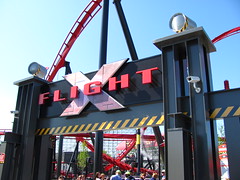 back rows would feel shut in, so they needed a new formula for simulating flight. 1999 saw the debut of the floorless coaster, which solved some of the visibility problems of the inverted configuration, but returning the track below the riders eliminated the sensation of being dangled above a landscape in open air, and the resulting perception was negligibly different from a sit-down design with raised seats. The introduction of the flying coaster in 2002 represented a more obvious attempt at capturing the feeling of free flight, and although the Superman positioning the rider and the unobstructed view got the “flight” part right, the hefty restraints and awkward gravitational pull on the body meant that the “free” part had taken a step backward. I think their greatest success in achieving a flight sensation was ironically found in a design
back rows would feel shut in, so they needed a new formula for simulating flight. 1999 saw the debut of the floorless coaster, which solved some of the visibility problems of the inverted configuration, but returning the track below the riders eliminated the sensation of being dangled above a landscape in open air, and the resulting perception was negligibly different from a sit-down design with raised seats. The introduction of the flying coaster in 2002 represented a more obvious attempt at capturing the feeling of free flight, and although the Superman positioning the rider and the unobstructed view got the “flight” part right, the hefty restraints and awkward gravitational pull on the body meant that the “free” part had taken a step backward. I think their greatest success in achieving a flight sensation was ironically found in a design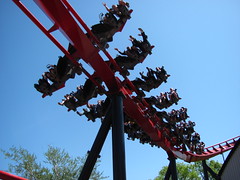 originally intended to simulate falling like a brick, when they gave their Dive Machines ten abreast floorless seating in 2007. Sitting on an outside row of the massive vehicle allowed for a clear view both above and below the rider as on the flying coaster, but the upright seating felt more natural and unobtrusive, the rider free to look where they pleased rather than be forced to gaze straight down with gravity.
originally intended to simulate falling like a brick, when they gave their Dive Machines ten abreast floorless seating in 2007. Sitting on an outside row of the massive vehicle allowed for a clear view both above and below the rider as on the flying coaster, but the upright seating felt more natural and unobtrusive, the rider free to look where they pleased rather than be forced to gaze straight down with gravity.
Twenty years after the inverted coaster was first introduced, B&M have returned to Six Flags Great America with a new roller coaster design that might finally achieve what they’ve always been striving for. By placing riders to the side of the track, the wing coaster combines the best aspects of the inverted and floorless designs, and places riders in a much more open, minimalistic seat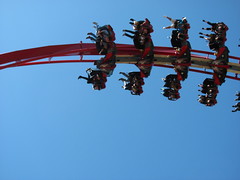 configuration than allowed by their flying coasters. Relative to its rather small scale, the new for 2012 X-Flight achieves a flying sensation better than any other coaster I’ve been on. It was also the first time in a long time I felt like I experienced something completely new and different on a B&M coaster. X-Flight is simultaneously graceful and unpredictable, and is the best roller coaster built at Six Flags Great America since either Raging Bull or Batman: The Ride, depending on if I count the former with or without trim brakes. I’m not exactly sure what the “X” is meant to signify, but whatever it is, it makes flight better than even Superman’s ultimate.
configuration than allowed by their flying coasters. Relative to its rather small scale, the new for 2012 X-Flight achieves a flying sensation better than any other coaster I’ve been on. It was also the first time in a long time I felt like I experienced something completely new and different on a B&M coaster. X-Flight is simultaneously graceful and unpredictable, and is the best roller coaster built at Six Flags Great America since either Raging Bull or Batman: The Ride, depending on if I count the former with or without trim brakes. I’m not exactly sure what the “X” is meant to signify, but whatever it is, it makes flight better than even Superman’s ultimate.
Now that I’ve taken care of the initial praise (if you’re looking for a simple “yay” or “nay” recommendation, the answer is “yay”),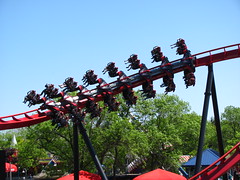 it’s time to get on with my favorite part of any ride analysis: the criticism. Although the wing coaster does “flight sensation” better than other configurations, it’s also the most limited in force and dynamic contrasts. There are various reasons for this, possibly owing to stress on the cantilevered wings (although the physiology of the rider is still probably the main limiting factor on forces, rather than the frailty of the steel arms), and a need to reduce vibrations that become amplified as they move further away from the track (I noticed some ‘flapping’ in the back rows, nothing too major but it could potentially lead to a headache depending on your constitution). However, the main reason the pacing and intensity must be slowed down on wing coasters is because the rider’s path lacks a single centerline. When the track begins to bank
it’s time to get on with my favorite part of any ride analysis: the criticism. Although the wing coaster does “flight sensation” better than other configurations, it’s also the most limited in force and dynamic contrasts. There are various reasons for this, possibly owing to stress on the cantilevered wings (although the physiology of the rider is still probably the main limiting factor on forces, rather than the frailty of the steel arms), and a need to reduce vibrations that become amplified as they move further away from the track (I noticed some ‘flapping’ in the back rows, nothing too major but it could potentially lead to a headache depending on your constitution). However, the main reason the pacing and intensity must be slowed down on wing coasters is because the rider’s path lacks a single centerline. When the track begins to bank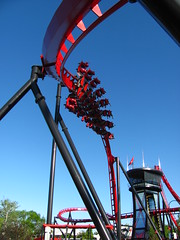 around a curve, riders on one side of the train will rise while those on the other will fall. Without a heartline that the track can be built around, there’s virtually no possibility for any tight rotational transitions on a wing coaster without encountering some really bizarre and possibly dangerous forces. All of the 4D coasters from S&S/Arrow or Intamin try to avoid inline transitioning as much as possible in favor of other ways to turn the track around, and while Furius Baco has a few fast corners, at 80mph the length of the transitions is still quite large compared to the wingspan of the trains (and I wouldn’t call that coaster a resounding success at rider comfort anyway).
around a curve, riders on one side of the train will rise while those on the other will fall. Without a heartline that the track can be built around, there’s virtually no possibility for any tight rotational transitions on a wing coaster without encountering some really bizarre and possibly dangerous forces. All of the 4D coasters from S&S/Arrow or Intamin try to avoid inline transitioning as much as possible in favor of other ways to turn the track around, and while Furius Baco has a few fast corners, at 80mph the length of the transitions is still quite large compared to the wingspan of the trains (and I wouldn’t call that coaster a resounding success at rider comfort anyway).
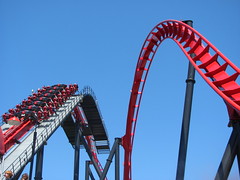 With that said, it should be very interesting to note that X-Flight’s layout seems to make more use of inline transitions than most other coaster configurations B&M have designed to date. There’s the twist at the top of the lift,
With that said, it should be very interesting to note that X-Flight’s layout seems to make more use of inline transitions than most other coaster configurations B&M have designed to date. There’s the twist at the top of the lift,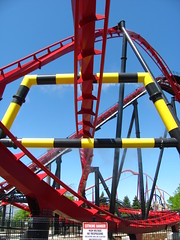 the first zero-G roll, the twist out of the Immelmann, the second zero-G roll/corkscrew, and then of course the signature inline barrel roll through the control tower, as well as a few other banking transitions sprinkled around the
the first zero-G roll, the twist out of the Immelmann, the second zero-G roll/corkscrew, and then of course the signature inline barrel roll through the control tower, as well as a few other banking transitions sprinkled around the layout. None of these rotations are taken very fast, but they’re still tight enough relative to the wingspan that you encounter some really funky dynamics. I’ve always wanted B&M’s designs to feel a little less controlled, and although I usually think about this in terms of force and pacing, losing control over the heartline also works
layout. None of these rotations are taken very fast, but they’re still tight enough relative to the wingspan that you encounter some really funky dynamics. I’ve always wanted B&M’s designs to feel a little less controlled, and although I usually think about this in terms of force and pacing, losing control over the heartline also works at returning some character to the experience.
at returning some character to the experience.
Back to the criticism: although the ride looked stunning on opening weekend with its blood red and graphite grey color scheme and bevy of modernistic props and architecture, I’m worried this look won’t age well and in a few years after it has lost its new coaster shine it will become another faded, thematically-incorrect steel monument on an empty square lot surrounded by the shells of disused special effects, and the high visibility of the structure on the midway will become a curse rather than a blessing. Six Flags doesn’t necessarily have the best track record in regards to this sort of upkeep (2008’s Dark Knight coaster has recently become divorced of its preshow, queue themeing, and music/sound effects, and the resulting attraction is now more depressing than it is lame), but for now I’ll retain my optimism that Six Flags will prove me wrong about X-Flight and enjoy the eye candy while it lasts.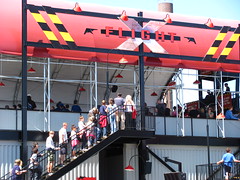
Also, as cool as X-Flight looks now, it looked a lot cooler when I rode it in California where it was called X2. Although for a coaster enthusiast the comparison between these two attractions might not be immediately obvious, from the perspective of the marketing department they’re virtually indistinguishable. Same color scheme, same clamshell steel station, same ambiguous “xtreme” theme, and even the logo has the exact same steel boilerplate design. The only difference is that X2 is much more theatrical and grandiose, and X-Flight has narrowed the theme down to something to do with stealth fighter jets, although I’m missing the ability to play with fun postmodern interpretations of the theme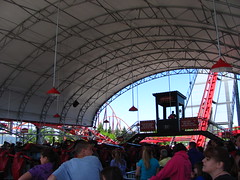 that X2’s vague pop culture references allowed.
that X2’s vague pop culture references allowed.
The station in particular needs some work. Aesthetically it leaves something to be desired, but I’ll ignore that for now and focus on logistics. If riders can’t exit on the opposite side of the train it needs either a separate unloading platform or something like the cattle pen boarding setup found on Eejanaika. Efficiency becomes an issue when they have to wait for everyone to gather their belongings and exit the far end of the platform before they can open the airgates for the next set of riders. Dispatch times on the whole could use a bit more work, but I guess that’s to be expected during the opening week of a new attraction. The winged design also presents a social problem: who gets the outside row?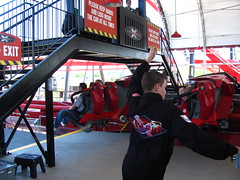 Since the winged seating is the primary gimmick separating X-Flight from other coasters at the park, the outside row has significantly more value for most riders than the inside row, and if lines are long and your riding partner and you are expecting this to be your first and only ride of the day, there’s going to be a discussion that ends with someone making a sacrifice. With me, it usually tends to be the other guy. (Sorry, Dan.)
Since the winged seating is the primary gimmick separating X-Flight from other coasters at the park, the outside row has significantly more value for most riders than the inside row, and if lines are long and your riding partner and you are expecting this to be your first and only ride of the day, there’s going to be a discussion that ends with someone making a sacrifice. With me, it usually tends to be the other guy. (Sorry, Dan.)
The seats are comfortable and the restraints are well designed. I wasn’t sure what I’d think of them because I can’t say I’m a big fan of the flexible vest/shoulder strap arrangement found on some of the newer Vekoma and Intamin coasters. While they eliminate the risk of any hard material playing ping-pong with your skull, they also tend to be a much snugger fit over the shoulders and keep anyone of even a moderate body build pressed firmly against the seat back; riders over six foot tall have reported even more discomfort with these than with the standard hard restraints. Thankfully, B&M resolved this issue by attaching the top of the vest to a retractable belt, which allows you to lean forward off the seat back without too much resistance (this is important should the ride ever pick up a rattle, plus it makes hanging over the diving first drop more fun), and it makes the restraints much more accommodating
and keep anyone of even a moderate body build pressed firmly against the seat back; riders over six foot tall have reported even more discomfort with these than with the standard hard restraints. Thankfully, B&M resolved this issue by attaching the top of the vest to a retractable belt, which allows you to lean forward off the seat back without too much resistance (this is important should the ride ever pick up a rattle, plus it makes hanging over the diving first drop more fun), and it makes the restraints much more accommodating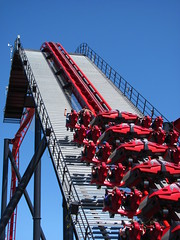 to riders of different body types.
to riders of different body types.
Now that we’ve made it into our seats, what about the ride experience that awaits?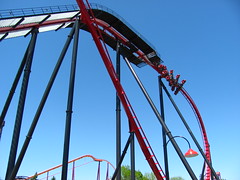 The chain lift incline is steeper than usual which means we reach the top in very short time, and coupled with the wide breadth of the catwalk makes the coaster appear shorter than 120’. But perhaps this illusion is for the best, if only because it makes cresting the lift and being greeted with the slow rollover into the initial dive loop feel much more shocking by comparison. I mentioned earlier that
The chain lift incline is steeper than usual which means we reach the top in very short time, and coupled with the wide breadth of the catwalk makes the coaster appear shorter than 120’. But perhaps this illusion is for the best, if only because it makes cresting the lift and being greeted with the slow rollover into the initial dive loop feel much more shocking by comparison. I mentioned earlier that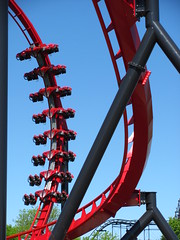 in many ways this coaster feels like a departure from the formulaic B&M design, and although I meant that mostly in regards to the unusual dynamics of a non-heartlined roller coaster, it also applies to the individual elements. This dive loop in particular is a refreshingly different way to gain kinetic energy, as I’ve become numb to the effects of the various curving and straight drops that have been implemented in various forms on roller coasters ever since the days of L.A. Thompson, with even beyond vertical drops becoming staid after more than a few times. I’m sure the dive loop first drop will eventually become tired as well if it’s repeated too often, but at this moment in history it’s something I’ve not encountered before, and I’m appreciative of that. Front row, left side is the best seat for experiencing this maneuver, mixing awkward hangtime and laterals with an uneasy feeling of vertigo as you rotate around the track and can look straight up, and then forward, at the ground below.
in many ways this coaster feels like a departure from the formulaic B&M design, and although I meant that mostly in regards to the unusual dynamics of a non-heartlined roller coaster, it also applies to the individual elements. This dive loop in particular is a refreshingly different way to gain kinetic energy, as I’ve become numb to the effects of the various curving and straight drops that have been implemented in various forms on roller coasters ever since the days of L.A. Thompson, with even beyond vertical drops becoming staid after more than a few times. I’m sure the dive loop first drop will eventually become tired as well if it’s repeated too often, but at this moment in history it’s something I’ve not encountered before, and I’m appreciative of that. Front row, left side is the best seat for experiencing this maneuver, mixing awkward hangtime and laterals with an uneasy feeling of vertigo as you rotate around the track and can look straight up, and then forward, at the ground below.
Most early reviews seem to cite the first and last inversions as X-Flight’s highlights, but I’d argue that the second inversion, a zero-G camelback roll, deserves special recognition as well. Sitting on the wing in the left side of the train, the seat is pulled out from under you and you do this strange weightless tango around the track that you can’t really predict beforehand. On standard coasters the heartline rolls might appear as crazy sections of track the way it curls around an invisible center path, but then the actual experience can feel very controlled. But on a wing coaster the opposite is the case, and the combination of looking mundane but then riding a bit off-kilter is far more effective psychologically. The track’s pathway is no longer necessarily your pathway, and the inability to visualize exactly how your body will be contorted next even as you trace the rail outline with your eyes is what allows X-Flight to be simultaneously unpredictable and graceful.
camelback roll, deserves special recognition as well. Sitting on the wing in the left side of the train, the seat is pulled out from under you and you do this strange weightless tango around the track that you can’t really predict beforehand. On standard coasters the heartline rolls might appear as crazy sections of track the way it curls around an invisible center path, but then the actual experience can feel very controlled. But on a wing coaster the opposite is the case, and the combination of looking mundane but then riding a bit off-kilter is far more effective psychologically. The track’s pathway is no longer necessarily your pathway, and the inability to visualize exactly how your body will be contorted next even as you trace the rail outline with your eyes is what allows X-Flight to be simultaneously unpredictable and graceful.
The next several maneuvers repeat this formula but without the same degree of remarkability of the first elements. The Immelmann inversion is basically an inverse of the first dive loop but absent the unique approach which means it gets lost amid the layout; the red-headed, unloved middle inversion, as it were. A water splashdown effect on the following ground-hugging turn is a neat change of pace, and although it doesn’t look
turn is a neat change of pace, and although it doesn’t look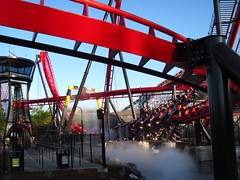 as natural or convincing as on Manta or Shambhala and serves mostly to get the right side of the train a little wet, it’s certainly better than nothing and I appreciate that they’re attempting to make every moment unique. The next inversion is similar to the first zero-G barrel roll I praised, but this one is more corkscrew-shaped than inline, and therefore the unpredictable
as natural or convincing as on Manta or Shambhala and serves mostly to get the right side of the train a little wet, it’s certainly better than nothing and I appreciate that they’re attempting to make every moment unique. The next inversion is similar to the first zero-G barrel roll I praised, but this one is more corkscrew-shaped than inline, and therefore the unpredictable dynamics are somewhat neutered. The low point of the ride is when we dip through a lame cut-out “jet hangar” on the exit of this inversion. This either needs to be made three-dimensional or should be scrapped altogether, because without any tunnel effect it’s completely forgettable on-ride, and off-ride it just looks cheap and makeshift, especially as it stands in a very visible location from both the queue and the main midway, and is immediately comparable to the much more attractive control tower nearby. The following inclined helix, although banked at nearly 90°, is the tamest part of the ride, and also the first time the winged seating isn’t put to good use.
dynamics are somewhat neutered. The low point of the ride is when we dip through a lame cut-out “jet hangar” on the exit of this inversion. This either needs to be made three-dimensional or should be scrapped altogether, because without any tunnel effect it’s completely forgettable on-ride, and off-ride it just looks cheap and makeshift, especially as it stands in a very visible location from both the queue and the main midway, and is immediately comparable to the much more attractive control tower nearby. The following inclined helix, although banked at nearly 90°, is the tamest part of the ride, and also the first time the winged seating isn’t put to good use.
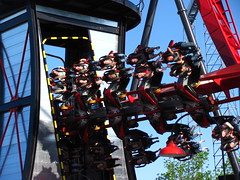 Just as it’s beginning to seem as if X-Flight would follow the same progression of diminishing action and anticlimax that plagues so many B&M designs, they throw a curveball and conclude with possibly the best part of the layout. The inline barrel roll makes maximum use of the Wing Coaster’s potential, combining the unusual dynamics of the non-heartlined configuration with the unique visuals of the open, exposed seating. I had heard reports that the visual near-misses on the other B&M wing coasters tend to go by unnoted, and while that was true of the 2D hangar, it’s not of the keyhole through the control tower. Granted, it didn’t exactly feel like a perilous near-miss (that we’ll rotate through the structure with plenty of clearance is never in any doubt, not even for a fleeting moment of instinctual response when it first comes
Just as it’s beginning to seem as if X-Flight would follow the same progression of diminishing action and anticlimax that plagues so many B&M designs, they throw a curveball and conclude with possibly the best part of the layout. The inline barrel roll makes maximum use of the Wing Coaster’s potential, combining the unusual dynamics of the non-heartlined configuration with the unique visuals of the open, exposed seating. I had heard reports that the visual near-misses on the other B&M wing coasters tend to go by unnoted, and while that was true of the 2D hangar, it’s not of the keyhole through the control tower. Granted, it didn’t exactly feel like a perilous near-miss (that we’ll rotate through the structure with plenty of clearance is never in any doubt, not even for a fleeting moment of instinctual response when it first comes into view) but it’s a cool visual effect nonetheless. It’s immediately followed by another special effect, a mist screen through the support columns as we’re turned completely upside down, and this technically can be considered a real collision, albeit a completely harmless one. (The mist was never on too strong that it became distracting, and I had no problems with it clouding up my glasses; yes, unsecured glasses are permitted on X-Flight, at least on the day of my visit.) The rotation speed of the twist is slow and stately,
into view) but it’s a cool visual effect nonetheless. It’s immediately followed by another special effect, a mist screen through the support columns as we’re turned completely upside down, and this technically can be considered a real collision, albeit a completely harmless one. (The mist was never on too strong that it became distracting, and I had no problems with it clouding up my glasses; yes, unsecured glasses are permitted on X-Flight, at least on the day of my visit.) The rotation speed of the twist is slow and stately,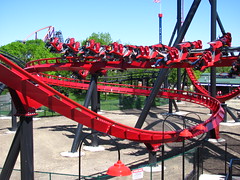 taking its time to hang us upside down before we’re once again righted. It’s an extended moment that lasts several beats longer than is normally expected from an inversion, which makes for a satisfying ‘grand finale’ to the entire experience. And that’s not counting the last helix, which is a nice denouement to release any remaining adrenaline before coming to a complete halt on the brakes; plus, tall folks on the far right side of the train might feel compelled to lift their feet up because they come very close to the ground.
taking its time to hang us upside down before we’re once again righted. It’s an extended moment that lasts several beats longer than is normally expected from an inversion, which makes for a satisfying ‘grand finale’ to the entire experience. And that’s not counting the last helix, which is a nice denouement to release any remaining adrenaline before coming to a complete halt on the brakes; plus, tall folks on the far right side of the train might feel compelled to lift their feet up because they come very close to the ground.
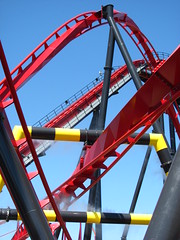 Comparing X-Flight to the similarly sequenced Swarm at Thorpe Park, I noticed where that ride seems to go wrong is that the barrel roll finale is too brief. You enter the brakes at the end thinking “is that all there is,” which is a very bad last impression to have if you want your ride to be considered a truly great attraction. (Of course, this is judging only from the POV videos and reading reviews that seem to corroborate this interpretation.) Even though they both have about the same rates of rotation, the Swarm starts the rollover already at 90° from the previous turn,
Comparing X-Flight to the similarly sequenced Swarm at Thorpe Park, I noticed where that ride seems to go wrong is that the barrel roll finale is too brief. You enter the brakes at the end thinking “is that all there is,” which is a very bad last impression to have if you want your ride to be considered a truly great attraction. (Of course, this is judging only from the POV videos and reading reviews that seem to corroborate this interpretation.) Even though they both have about the same rates of rotation, the Swarm starts the rollover already at 90° from the previous turn,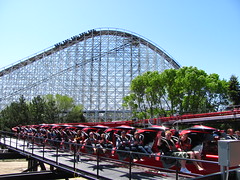 and ends as soon as it levels out into the brakes, meaning there’s only about 270° of rotation. X-Flight’s barrel roll, on the other hand, has two banked curves bordering either end that turn in the opposite direction of the roll, so the motion is unbroken for at least 450° of rotation. This stretches it out for several beats and makes
and ends as soon as it levels out into the brakes, meaning there’s only about 270° of rotation. X-Flight’s barrel roll, on the other hand, has two banked curves bordering either end that turn in the opposite direction of the roll, so the motion is unbroken for at least 450° of rotation. This stretches it out for several beats and makes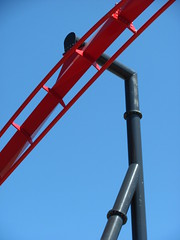 it feel like a completed action, whereas the Swarm still feels unresolved by the time you reach the brakes.
it feel like a completed action, whereas the Swarm still feels unresolved by the time you reach the brakes.
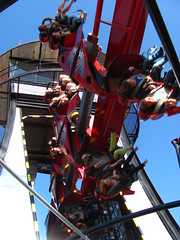 I know it’s not exactly considered good etiquette among coaster enthusiasts to compare rides you haven’t been on yet; apparently we’re all strict empiricists and can make absolutely no a priori claims about the world until we’ve encountered it first hand; this seems like bad news for the designers, whose best hope is to randomly plug together elements and hope the final result is okay. However, this feeling of completeness and resolution at the end of X-Flight seems to be missing from the other Wing Coasters, at least to the same degree,
I know it’s not exactly considered good etiquette among coaster enthusiasts to compare rides you haven’t been on yet; apparently we’re all strict empiricists and can make absolutely no a priori claims about the world until we’ve encountered it first hand; this seems like bad news for the designers, whose best hope is to randomly plug together elements and hope the final result is okay. However, this feeling of completeness and resolution at the end of X-Flight seems to be missing from the other Wing Coasters, at least to the same degree,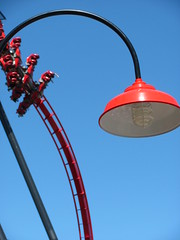 and I feel I can claim with a certain degree of confidence that X-Flight has the best layout of the four built so far. Of course, I reserve all claims about which of the four built so far is the best overall until I’ve actually ridden them, as there are too many other variables not present on X-Flight, most notably the stronger themeing on Swarm and Raptor, the additional height and speed on Swarm and Wild Eagle, or the natural forested setting of Wild Eagle.
and I feel I can claim with a certain degree of confidence that X-Flight has the best layout of the four built so far. Of course, I reserve all claims about which of the four built so far is the best overall until I’ve actually ridden them, as there are too many other variables not present on X-Flight, most notably the stronger themeing on Swarm and Raptor, the additional height and speed on Swarm and Wild Eagle, or the natural forested setting of Wild Eagle.
Regardless, X-Flight is certainly as good a roller coaster as I ever could have hoped for given the limited land and creative talent available at Six Flags Great America, not that my expectations were that high to begin with. I’m still waiting for the day when a new coaster will be announced that will do for the wing coaster what Tatsu did for the flying coaster, but judging on the relative successes of the design so far (especially compared to the still somewhat lackluster Air and Supermen models), if/when that day comes, the results should hopefully be one of Bolliger and Mabillard’s top career achievements.
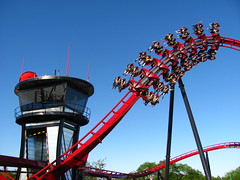
If the standard of comparison for new rides is Maverick, then you and I can expect to be disappointed a lot. 😉
One thing I’ve noticed about Six Flags Great America is they tend to be more experimentally-minded and buy more prototype technologies than their competitors or other parks in the Six Flags chain do. They bought the first stand up coaster from B&M, the first inverted coaster, one of the first speed coasters, and were very early adopters of both the flying coaster technology and now the wing coaster technology. The major problem with this strategy is that after a couple of years some one else will inevitably build a bigger and better coaster that realize more of the hidden potential of the technology.
Cedar Point uses the opposite strategy as Great America, waiting until new technologies have been tested and proven at other parks before they order it for themselves, when they can make it bigger, longer, and better, and their collection is therefore able to better stand the test of time and dominate the top ten lists over the long term as a result. The irony is, parks like Cedar Point need parks like Great America to exist, otherwise we’d never get anything original or good.
Like I said, I agree with nearly every addition/choice the park has added or made… The go-kart relocation highly aggravated me because not only did we lose a small but great children’s section, they took away some appeal to Little Dipper. The Little Dipper was my first roller coaster I had ever ridden back at Kiddieland so I was more than enthusiastic when it came to SFGAm. Within one year, I felt they treated it like the historic machine it is to treating it as if it was in the way when in reality it’s the other way around. The go-karts take up all that space that was once a perfect family setting.
As for where the park should be at this point, I would agree. For being the main park in that entire area, it delivers but often is under-rated sadly. As you know, the park thrived on family entertainment after 2003 especially. They marketed the Dark Knight in the wrong direction while trying to maintain that family balance & aspect they had been aiming for years prior which they did great with in 2004, 2005, & 2007.
When I was at the park in early 2008, I have to say I was heart broken over the removal of DejaVu. Seriously. It was simply my favorite ride at the park. As many may think was a childish act of protest, my friend & I sported shirts that read “R.I.P DEJA VU – #@$&! This, were headin’ to Cedar Point” & thats exactly what we did. However, word spread about our shirts & park president Hank came up to us & said “so these are the shirts Ive been hearin’ about all day.” I was blunt & told him he had told me in previous years the rumors were false about its demise & that if it functioned properly they would keep it. Now of course any manager, spokesperson etc. is going to want to set aside & rest rumors. Though, being hopeful I believed a man who worked at the park I called home. He told me after I spoke my opinions & heartache that: “What goes there next year(2009), will be an INSPIRATION to burn those t-shirts!” Needless to say, I had no “inspiration” to burn my shirt at all until this May. Though it did not go up into flames it was thrown away just a couple weeks ago. haha
Though I’m more than delighted with the addition of X-Flight, I never stop feeling like something is missing from my park. It’s sad to admit but it’s true. I used to tell myself the only thing I’d want to see Deja Vu replaced with is another GIB or a B&M dive machine. I felt we needed that vertical drop back again. It was the simplicity of Deja Vu’s layout that amazed me because it was suspenseful & delivered intensity. It was eye candy for spectators & one hell of a thrill for riders. It simply was – bliss.
^ Yes, I never got to ride Deja Vu at Great America, as my first visit was 2008 (I have since gone every year multiple times). However, I actually passed by Silverwood while on vacation in ’08 and got to ride it as Aftershock. Great ride, I got to ride it five or six times, never saw it break down. Still now, it’s one of my favorite coasters. I wish it was still at Great America as it would be my favorite ride in the park.
i thought that x flight was built free handedly, in other words it wasnot another roller coaster in the past like how iron wolf is to a Apocolapes in Washington d.c.
what’s you opinion on Gatekeeper being built at Cedar Point ?
Gatekeeper looks good, and I’ll probably like it better than X-Flight. It’s bigger, longer, has some cool maneuvers, all of which will probably make far better use of the “flight” sensation the wing coaster is designed for. I appreciate the conceptual theme, which seems to unite ideas/feelings of “crossing through barriers and over voids” (both at the front gate and on the ride itself; I’ll be curious to see how much of this design style they can carry over into the ride entrance and station area), and enhanced by the air/water/sand color scheme, (and I swear I’ll do a much more elegant job of describing this whenever I get a chance to write an actual review of it).
I have two major reservations. One, X-Flight seems to have the better overall element sequence. As I said in the review, the long 540 degree rotation in the barrel roll finale, which naturally transitions into the helix denouement, makes for a really great closer that gives every element up to the very end a sense of emotional purpose. Gatekeeper, by contrast seems to climax halfway through with the keyhole inversion, followed by two inversions that I’m sure will be nice but compared to the colossal first half will probably indicate the start of “the climb back down the mountain”, so to say, and then everything after the midcourse brake just seems like a waste except for to pad out the ride time so you feel like you’re getting more for your money (or time spent in line). Maybe the really tight downward helix will prove interesting on a wing design, I’ll have to see for myself.
The other thing I’m scratching my head over is the gaps in the keyhole supports. They choose a design that emphasizes the impression left by the formal outline of geometric shapes, but then disrupt this form with a big line of negative space through the middle that the eye is automatically drawn to. The eye follows this negative space, and then it reaches the utilitarian bolted connectors between the two pieces, which is where the focus of the keyhole tower finishes. I understand the need to check the bolts, but they should have found a way to either cover the gap in a way that the bolts could still be accessed when needed (like once a year in the off-season?), or chosen a different aesthetic design for the towers that would work better with the construction constraints facing their installation.
It’ll probably be a while before I get to ride it, let alone write about it, so hopefully for anyone who likes reading my analysis, this pre-review (does that cancel out and make it just a “view”?) will suffice for now.
Thank’s for the quick response ! I completely agree with everything you said.